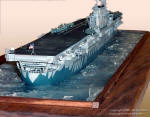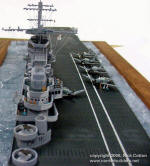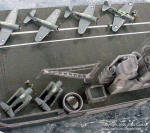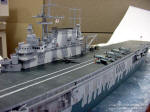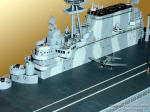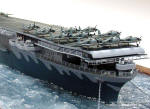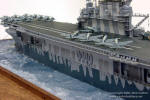|
With her
bizarre camouflage scheme, Hornet is quickly recognizable to most model
ship builders.
She was the shortest-lived of any US Fleet carrier, but her few months
of service were packed with enough heroics for any warship to be proud
of. The Doolittle raid, Midway and the immortal sacrifice of Torpedo
Eight, Santa Cruz, island raiding, Hornet was busy from the day she hit
the water until the day she slid under it forever.
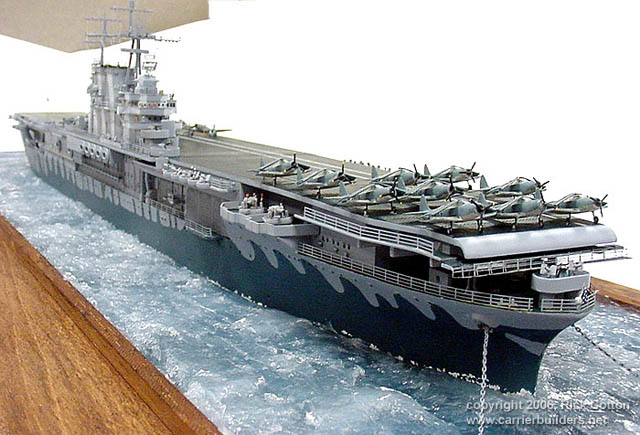
This model is
dedicated to the memory of those brave Americans who sailed forth to war in
her, and never returned.
Trumpeterís
new 1/350th scale kit is well-documented on the web for its incorrect
bow and a few other minor goofs, but I noticed only one other thing out
of whack. The deck crane should be directly behind the islandÖTrumpeter
has it slightly offset to port, thus creating a landing hazard for
incoming pilots. Oh, well, be careful setting Ďem down boysÖ.
The hangar deck and hull are a good tight fit. I filled a few seams with
Squadron White Putty,and sanded off the molded-on anchor chains,
replacing them with Haze Gray-painted jewelry store chain. I drilled out
the openings for the anchors, as I wanted to display the ship moored in
harbor, with her anchors out. The hangar deck floor was sprayed Testors
Gunship Gray, and then masked.
The hangar
deck bulkheads (thatís WALLS to you land lubbers) had to be detailed
inside with bits of plastic and resin, then sprayed flat white, as was
the overhead (the underside of the flight deck or CEILING). I cut open
some of the rollup doors in the aft section to show some Hangar detail.
I added Plastruct I-beams to simulate the underdeck support for the
flight deck.
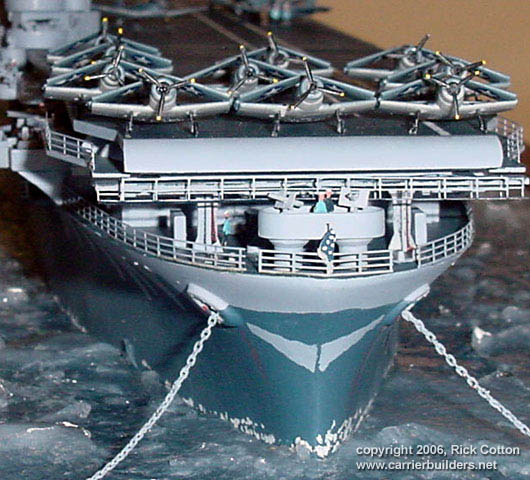
At this point, I built up one TBD Devastator and two SBD Dauntlesses and
posed them on the hangar deck before closing this area up.
Take care to
test-fit and align the bulkheads as close to vertical as possible, as this
will save you much grief during the flight deck fitting.
I didnít
follow the exact sequence of assembly and painting in the directions,
since I was adding the Tomís Modelworks brass photoetch as I went along.
This required painting and building, painting and building, basically in
layers as I moved up from the waterline.
All external surfaces got a base coat of PollyScale Acrylic Haze Gray
(you know, ďhaze gray and underway..Ē), the decks got Pollyscale
Weathered Deck Blue and then the Pollyscale Navy Blue pattern was added
to the hull, along with appropriate rust, stains and streaks.
By the way, Trumpeterís full color plan included with the kit is an
approximation only, check your reference photos carefully for a more
exact pattern. Their depiction of dark blue striping on the Island is
just flat wrong. Check out the cover of Warship Perspectives Yorktown
Class Carriers, and there is Hornet, in beautiful Technicolor, with Pale
Gray stripes on her island! I tried a test pattern on a blank sheet of
white card of the Navy Blue, Ocean Gray, Haze Gray pattern as written in
the book, but it just didnít look right, and certainly didnít look like
the photo, so I shot the model in Navy Blue, Haze Gray, and Pale Gray.
The pattern was applied hard-edged, just like the original.
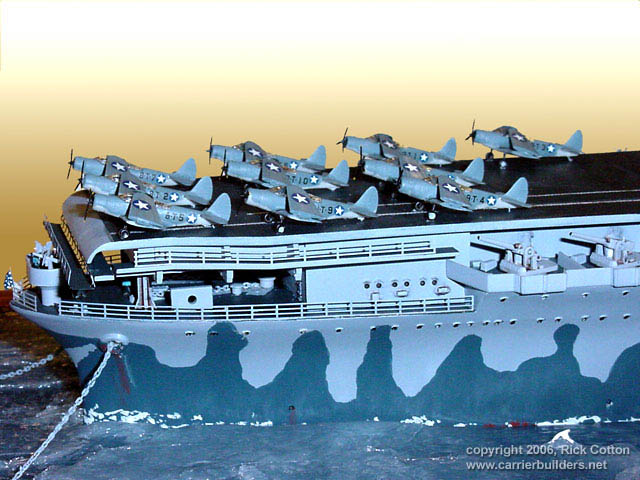
Lastly, I added
the badly chipped white Bow Wave. On the real boat, there wasnít much left
of this after the Doolittle raid, but what was there stood out. The flight
deck was also painted Pollyscale Weathered Deck Blue with a few drops of
white added, and got some tan drybrushing to simulate the wearing of the
original Norfolk Blue deck stain. I used some smeared black pastel chalk to
simulate tire skid marks in the landing area, then sealed the entire deck
with Testorsí Acrylic Clear Flat.
I didnít use
the photoetch props and wheels provided for the air wing, the kit parts
are super as they are.
One exception was the use of the landing gear parts for the F4F
Wildcats. Those really show up when added, and help stabilize the weak
gear of these planes.
Also, if you are doing Wildcats, remember that dash-3 models didnít have
folding wings, while dash-4 ones did. I believe the Marines got the
Dash-3ís, so I did Dash-4ís on Hornet. The SBDís didnít have folding
wings (mustíve been a nightmare stashing them below decks) and the TBDís
wings folded all the way down to the top of the ďgreenhouseĒ canopy.
I did use most of the Tomís Modelworks details, however. They really add
to the crane, radar fit, guns and island, and are fairly easy to apply,
with the exception of that %$^&*# railing around the top of the funnel.
Talk about a pain in the posterior! Donít do that part until the
caffeine wears off.
A couple of sets of Tomís Modelworks 1/350th scale sailors, and a few
extra Torpedo Eight TBDís and some SBDís on deck finished off the boat
itself.
The ship was
mounted in ďwaterĒ made of clear silicone caulk, in one thin layer, over
a deep blue painted base. Let this stuff cure in a WELL VENTILATED
roomÖitíll stink the place up if you donít.
Okay, there she is. Even with Trumpeterís errors, itís a super kit. Iím
really a plane builder by nature, but I love flattops too.
On to Essex!
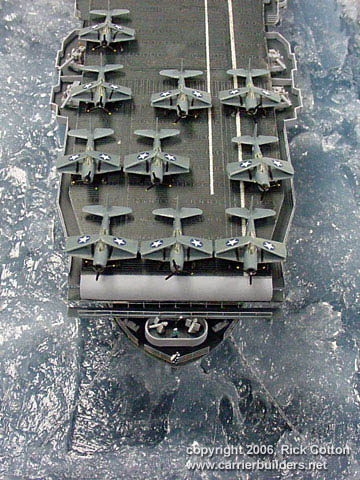
Photos © 2006 by
Rick Cotton
May 23, 2006
www.carrierbuilders.net |




